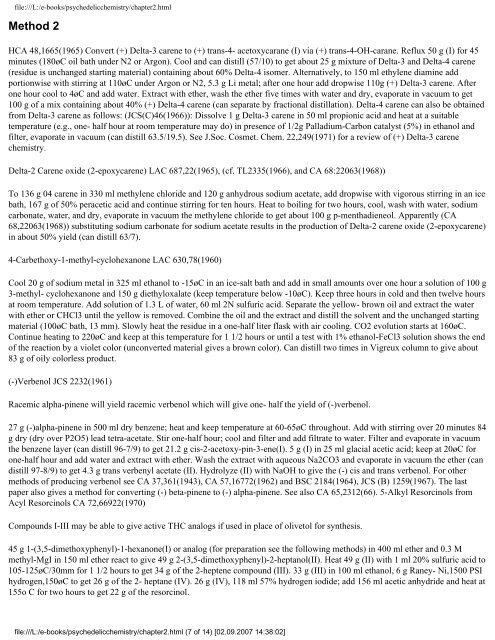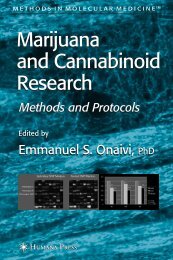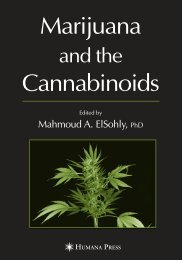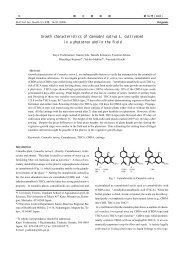file:///L:/e-books/psychedelicchemistry/chapter2.htmlMethod 2HCA 48,1665(1965) Convert (+) Delta-3 carene to (+) trans-4- acetoxycarane (I) via (+) trans-4-OH-carane. Reflux 50 g (I) for 45minutes (180øC oil bath under N2 or Argon). Cool and can distill (57/10) to get about 25 g mixture of Delta-3 and Delta-4 carene(residue is unchanged starting material) containing about 60% Delta-4 isomer. Alternatively, to 150 ml ethylene diamine addportionwise with stirring at 110øC under Argon or N2, 5.3 g Li metal; after one hour add dropwise 110g (+) Delta-3 carene. Afterone hour cool to 4øC and add water. Extract with ether, wash the ether five times with water and dry, evaporate in vacuum to get100 g of a mix containing about 40% (+) Delta-4 carene (can separate by fractional distillation). Delta-4 carene can also be obtainedfrom Delta-3 carene as follows: (JCS(C)46(1966)): Dissolve 1 g Delta-3 carene in 50 ml propionic acid and heat at a suitabletemperature (e.g., one- half hour at room temperature may do) in presence of 1/2g Palladium-Carbon catalyst (5%) in ethanol andfilter, evaporate in vacuum (can distill 63.5/19.5). See J.Soc. Cosmet. Chem. 22,249(1971) for a review of (+) Delta-3 carenechemistry.Delta-2 Carene oxide (2-epoxycarene) LAC 687,22(1965), (cf. TL2335(1966), and CA 68:22063(1968))To 136 g 04 carene in 330 ml methylene chloride and 120 g anhydrous sodium acetate, add dropwise with vigorous stirring in an icebath, 167 g of 50% peracetic acid and continue stirring for ten hours. Heat to boiling for two hours, cool, wash with water, sodiumcarbonate, water, and dry, evaporate in vacuum the methylene chloride to get about 100 g p-menthadieneol. Apparently (CA68,22063(1968)) substituting sodium carbonate for sodium acetate results in the production of Delta-2 carene oxide (2-epoxycarene)in about 50% yield (can distill 63/7).4-Carbethoxy-1-methyl-cyclohexanone LAC 630,78(1960)Cool 20 g of sodium metal in 325 ml ethanol to -15øC in an ice-salt bath and add in small amounts over one hour a solution of 100 g3-methyl- cyclohexanone and 150 g diethyloxalate (keep temperature below -10øC). Keep three hours in cold and then twelve hoursat room temperature. Add solution of 1.3 L of water, 60 ml 2N sulfuric acid. Separate the yellow- brown oil and extract the waterwith ether or CHCl3 until the yellow is removed. Combine the oil and the extract and distill the solvent and the unchanged startingmaterial (100øC bath, 13 mm). Slowly heat the residue in a one-half liter flask with air cooling. CO2 evolution starts at 160øC.Continue heating to 220øC and keep at this temperature for 1 1/2 hours or until a test with 1% ethanol-FeCl3 solution shows the endof the reaction by a violet color (unconverted material gives a brown color). Can distill two times in Vigreux column to give about83 g of oily colorless product.(-)Verbenol JCS 2232(1961)Racemic alpha-pinene will yield racemic verbenol which will give one- half the yield of (-)verbenol.27 g (-)alpha-pinene in 500 ml dry benzene; heat and keep temperature at 60-65øC throughout. Add with stirring over 20 minutes 84g dry (dry over P2O5) lead tetra-acetate. Stir one-half hour; cool and filter and add filtrate to water. Filter and evaporate in vacuumthe benzene layer (can distill 96-7/9) to get 21.2 g cis-2-acetoxy-pin-3-ene(I). 5 g (I) in 25 ml glacial acetic acid; keep at 20øC forone-half hour and add water and extract with ether. Wash the extract with aqueous Na2CO3 and evaporate in vacuum the ether (candistill 97-8/9) to get 4.3 g trans verbenyl acetate (II). Hydrolyze (II) with NaOH to give the (-) cis and trans verbenol. For othermethods of producing verbenol see CA 37,361(1943), CA 57,16772(1962) and BSC 2184(1964), JCS (B) 1259(1967). The lastpaper also gives a method for converting (-) beta-pinene to (-) alpha-pinene. See also CA 65,2312(66). 5-Alkyl Resorcinols fromAcyl Resorcinols CA 72,66922(1970)Compounds I-III may be able to give active THC analogs if used in place of olivetol for synthesis.45 g 1-(3,5-dimethoxyphenyl)-1-hexanone(I) or analog (for preparation see the following methods) in 400 ml ether and 0.3 Mmethyl-MgI in 150 ml ether react to give 49 g 2-(3,5-dimethoxyphenyl)-2-heptanol(II). Heat 49 g (II) with 1 ml 20% sulfuric acid to105-125øC/30mm for 1 1/2 hours to get 34 g of the 2-heptene compound (III). 33 g (III) in 100 ml ethanol, 6 g Raney- Ni,1500 PSIhydrogen,150øC to get 26 g of the 2- heptane (IV). 26 g (IV), 118 ml 57% hydrogen iodide; add 156 ml acetic anhydride and heat at155o C for two hours to get 22 g of the resorcinol.file:///L:/e-books/psychedelicchemistry/chapter2.html (7 of 14) [02.09.2007 14:38:02]
file:///L:/e-books/psychedelicchemistry/chapter2.html5-Alkyl Resorcinals BER 69,1644(1936)25g ethyl-3,4,5-trimethoxybenzoyl acetate and 2.1 g Na in 100 ml ethanol; warm to react. Add 2 g n-propyl iodide (or n-amyliodide, etc.) and heat twelve hours on steam bath; neutralize and distill off the ethanol. Extract with ether and dry, evaporate invacuum to get about 32 g of the alkyl acetate (I). Heat 22 g (I) in 5% KOH in ethanol for one hour at 50øC to get 14 g 3,4,5-trimethoxyvalerophenone (II), which crystallizes on standing. 11 g (II), 600 ml ethanol, 60 g Na; warm and after Na is dissolved,add 2 L water. Acidify with HCl, distill off the ethanol and extract with ether. Dry, evaporate in vacuum the ether to get 7.8 golivetol dimethyl ether (or analog) (III). 7.2 g (III), 70 ml hydrogen iodide; boil two hours and distill (164/760) to get Olivetol.Olivetol HCA 52,1132(1969)Reduce 3,5-dimethoxybenzoic acid with lithium aluminum hydride to 3,5- dimethoxybenzyl alcohol (I). to 10.5 g (I) in 100 mlmethylene chloride at 0ø C add 15 g PBr3; warm to room temperature and stir for one hour. Add a little ice water and then moremethylene chloride. Separate and then dry, evaporate in vacuum the methylene chloride. Add petroleum ether to precipitate about11.5 g of the benzyl bromide (II). To 9.25 g (II), 15 g CuI, 800 ml ether at 0ø C, add butyl (or other alkyl)-Li (16% in hexane), andstir for four hours at 0ø C. Add saturated NH4Cl and extract with ether. Dry and evaporate in vacuum the ether (can distill100/0.001) to get about 4.5 g olivetol dimethyl ether (III) or analog. Distill water from a mixture of 90 ml pyridine, 100 mlconcentrated HCl until temperature is 21 0øC. Cool to 140øC and add 4.4 g (III); reflux two hours under N2. Cool and pour intowater. Extract with ether and wash with NaHCO3. Make pH 7 and dry, evaporate in vacuum to get 3.8 g olivetol which can bechromatographed on 200 g silica gel (elute with CHCl3) or distill (130/0.001) to purify.5-Alkyl Resorcinols TET 23,77(1967)Since the method as given originally leads to 4-alkyl resorcinols which do not produce an active THC, it is here modified to give the5-alkyl isomers. The method is illustrated for 1.2-dimethyl-heptyl resorcinol which gives a much more active THC than olivetol.Convert 3,5- dihydroxyacetophenone (5-acetyl resorcinol) to 3,5- dimethoxyacetophenone(I) in the usual way with dimethylsulfate.To 24 g Mg, 1 crystal 12, 100 ml ether, add dropwise under N2, 180 g 2- Br-heptane in 100 ml ether over one hour and then refluxtwo hours. Add over 1 1/2 hours a solution of 90 g (I) in 200 ml tetrahydrofuran and reflux 10 hours. Cool and add 180 ml saturatedNH4Cl; decant the solvents and extract the residue with tetrahydrofuran. Combine the solvents and the tetrahydrofuran and dry,evaporate in vacuum. Add a few drops 20% sulfuric acid to the residual oil and evaporate in vacuum the water (oil bath temperature120-130øC/10mm). Distill the oil at oil bath temperature 285øC/0.2. Fraction boiling 128-140/0.2 yields about 60 g 2- (3,5-dimethoxyphenyl)-3-methyl-2-octene(II). If saponified and used to synthesize a THC, this might give an active product, thusdisposing of the necessity of the next step. Hydrogenate 50 g (II) in 100 ml ethanol, 2-3 atmospheres H2, 0.6 g 10% Palladium-Carbon catalyst for two hours, or until no more H2 uptake (or use the NaBH4-Ni method described at the start). Filter and dry,evaporate in vacuum, and distill the residual oil (110-17/0.1) to get 42g of the octane (III). 40 g (III), 100 ml 48% HBr, 320 mlglacial acetic acid and reflux four hours. Pour on ice and take pH to 4.5 with 10 N NaOH and extract with ether. Extract the etherwith 3x150 ml 2N NaOH; acidify the combined NaOH extracts with glacial acetic acid and extract with ether. Dry and evaporate invacuum, and distill the oil ( 159/0.1 ) to get 20 g 5-1, 2-dimethylheptyl resorcinol.5-Alkyl Resorcinols JACS 61,232(1939)Convert benzoic acid to 3,5-dihydroxybenzoic acid (alpha-resorcyclic acid) (I). 50 g (I), 134 g dimethylsulfate, 60 g NaOH, 300 mlwater; add 35 g NaOH and reflux to obtain about 50 g 3,5-dimethoxybenzoic acid (II) which is converted to dimethoxybenzoylchloride (III) with PCl5. Extract the (III) with ether and filter. Saturate the ether with NH3 at 0øC and filter. Wash with ether andwater and recrystallize from hot water to get 3,5-dimethoxy-benzamide (IV). To a solution of 1 M of n-hexyl bromide (or 1,2-dimethylheptyl bromide, etc.) add 24.3 g Mg in 200 ml ether to prepare the Grignard reagent. Then rapidly add 46 g (IV); add 300ml ether and reflux and stir two days, excluding moisture and air. Add a mixture of ice and water and 80 ml concentrated sulfuricacid. Separate and dry, evaporate in vacuum the ether layer to get about 50 g of the dimethoxyalkyl benzyl ketone (V). Recrystallizefrom dilute ethanol. Add 0.2 M (V), 20.8 g 100% hydrazine hydrate, 75 ml ethanol; reflux six hours. Evaporate in vacuum and heatthe residual oil with 82 g powdered KOH in oil bath about 225øC until N2 evolution ceases. Can distill or recrystallize from 95%ethanol to get the dimethoxyalkyl benzene (VI). 0.025 M (VI), 40 ml glacial acetic acid, 15 ml 48% HBr; reflux four hours and pourinto ice water; decolorize with a little Na bisulfite, neutralize with NaHCO3 and extract with ether. Wash the extract with 10%NaOH and separate and acidify the basic solution. Extract with ether and dry, evaporate in vacuum the extract to get the 5-alkylfile:///L:/e-books/psychedelicchemistry/chapter2.html (8 of 14) [02.09.2007 14:38:02]






